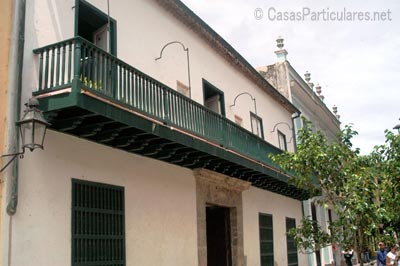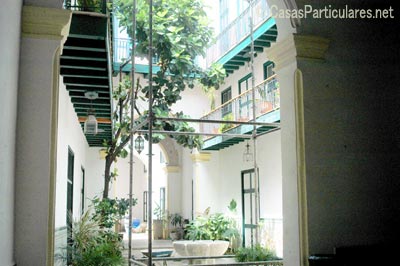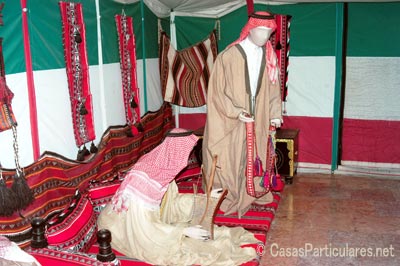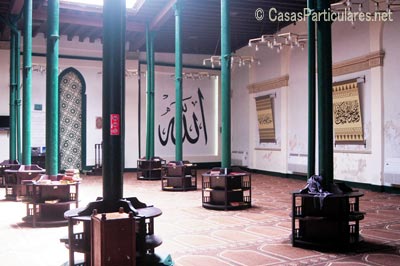The Arabian Museum in Old Havana
By Anonymous, translated from Spanish by Danil Ren.
The Arabian House, an Authentic Home
The museum Arabian House in Havana was launched on November 16 1983, thanks to a restoration project organized by the City Historian's Office.
Known as the first ethnographic museum in the Cuban capital, it works with the aim to brig to Cuba the values of Arabic culture, throughout its traditions, architecture, costumes and arts.
The study of the Arabic presence in the Caribbean Island, starting from the Spanish colonization era to the big migratory movement between the XIX and the XX centuries, is another of that institution goals, since, between 1906 and 1913, 3758 migrants arrived to Cuba between Arabs, Turks and Egyptians.
A few years after, between 1920 and 1931, another 9337 migrants arrived, such as Arabs, Lebanese, Palestinians and Syrians. They began an insertion process in the Cuban society in several areas, such as occupation, religion, marriages or traditions conservation or association.
One of the main attractions of this place is that many of the items inside it was donated by Cuban prestigious personalities, including the Cuban Revolution leader Fidel Castro Ruz, or his brother, also Commander, Raúl Castro.
The building hosting the Arabian House, was built at the end of the XVIII century and at the beginning of the XIXth. It initially hosted the Saint Ambrose college, between 1689 and 1774. While the first owner of the building, which was later called the "Notaries House" was Ambrosio Marcos Zayas Bazán.
The current building was restored and inaugurated on February 20, 1997, with new ideas including the exposition of maps with legends related to the Islamic Arab culture.
Expositions of Perpetual Attraction
There are seven permanent exposition rooms in the museum. For example the Arab Immigrant room, with documents, images and personal objects belonged to Arabs who moved to Cuba and which show the live of day to day merchants.
This room is also a testimony of scientists, politics and so on, aside from the history and culture of descendants from Moorishs, who also contributed to the Cuban nation, many personalities such as the Juan and Pedro Kourí doctor, this latter the innovator of guayabera(1), Said Selman Hussein or the pianists Ñola Sahig, just to cite some.
From its side, the Ways of life room contains some pieces related to arabic habits and behaviours in every day life. This room describes ethimologically daily elements related to the arabic relationship with the desert, the sea, the fauna and the water.
We can also appreciate the Bedouin environment from North Africa, the inside of a tent or how we develop the fishing or the pearl, an activity related to maritime peoples from the Arabic peninsula.
Maybe the most interesting room from the visitor's point of view is the Weapons Room, a space where we can appreciate the tools with the Islamic armory stylistic and techniques, from several locations of the Middle East.
You can find there a collection of jambiyas, among the most used weapon in the XVII and XVIII centuries, which is also employed during circumcision rituals or nuptial ceremonies.
On the other hand, ceremony sabers are particularly standing out as well as the spark rifles from the XIX century, from Europe and made for the commerce with North Africa, or the Turkish yatagans and the XIX century gomies, which are typical daggers from the North region of the African continent.
Most of the weapons are totally covered in gold and silver and also adorned with with extreme delicacy. It's about one of the most complete collections available in Cuba.
The El Zoco room reproduces an Arab market with areas devoted to costumes, carpets, steel pieces and other materials, as well as many ambiances representing scenes about selling of coffee and several other products.
For lovers, there is the Romantic room with a collection adorned with objects that belonged to Cuban families and personalities who have traveled in the Middle-East, Asia, North Africa and South Spain.
For example, we find paintings, clothers and other personal items belonged to the Cuban writer Dulce María Loynaz del Castillo and her family, there relics were donated to the museum and they are standing out in the collection exposed in this room.
The Room of Prayer is not only the only in its gender in Cuba, but also in Latin America in general and there, many decorative elements that are proper of Islam are recreated. We can also find the Mihrab, a sepulchre indicating the Quibla, oriented in direction of the Makkah, a site where Muslims address their prayers, and the Minbar, a tribune from which the Iman direct the praise.
While in the Hispano-Arabic Room we exhibit pieces about the Arabian influence in the Hispanic culture. For example the collection of furnitures coming from the XVI, XVII, XVIII and XIX centuries, generally made in Spain, with a predominance of geometric Muslim art and intarsia technique.
In the last instance and not less important is the room devoted to the Pre-Islamic Civilizations, where several objects that belonged to Pre-Islam culture are exposed, for example items coming from the Babylonian culture, which arrived to countries such as Egypt, Iraq and Syria.
In this room we can admire the Egyptian parchments which make to discover the religious life if this ancient culture, throughout hieroglyphics, sculptures and carpets.
The pearls of the Arabic culture are inside each one of these rooms, and they are many, such as the Desert Roes, a strange calcified formation which simulates a flower and which can be found in sandy surfaces, as well as a good quantity of inlaids made from different precious woods and nacres.
Much More Than a Simple Museum
The Arabian House of Havana is much more that just a museum with admirable inanimate figures. The institution also offers several cultural and educative programs, as well as several guided visits, concerts, conferences, expositions, dance spectacles, introduction of books, political meetings, tasting of typical meets, exhibition of traditional costumes, superior courses, and finally social care with community children or old people.
Among the multiple function of this house, we also find the reunion of devotees, not only Arabs, but also Asiatic or Africans resident in Cuba, even if, in reality, the doors are also opens for non-resident Muslims.
Inside the museum, there is also a library, better known as Ibn Jaldun, which possesses substantial collections of either Islamic and Arabic material, including a compilation of the Koran.
Also, you can find reproductions dated from the XIX century, essays about Islam and some passages on history of Arabian and Islamic art in the modern epoch.
Where the Museum is Located?
The Arabian Museum is located in the Oficios street at 16th number between Obispo and Obrapía streets, in Old Havana. It's open from 8:30 AM to 4:30 PM, from Tuesday to Friday.
You can also email it to arabes@bp.patrimonio.ohc.cu, if you want more details about the place.
According to Dr. Rigoberto Menéndez, the director of the museum for more than 20 years, in Cuba there is not an Arabian community, but only a society related to the Arabian Union of Cuba, made by more than 70,000 descendents who had several solidarity acts with the nation of their ancestors; therefore the Arabian House is much more than a house, either for the descendant than for any other people interested on it.












